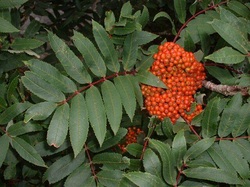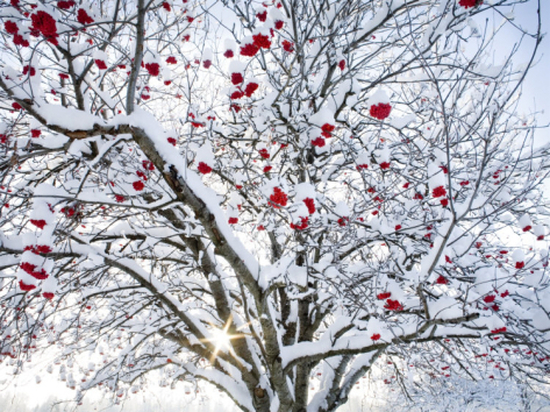Truth -The Mountain Ash

Truth
To be able to examine the world with unflinching eyes and remove it from the boxes of perception that we have had ingrained in us from birth is an amazing act of courage. Sometimes a chisel may be needed. Likewise, honesty with ourselves and with others must not be handled carelessly. While we interact with society, we must also keep the truth of our own experiences and knowledge before us. Learning to share that truth in ways that can be chewed and digested is often arduous but important to the health of ourselves and our community. Providing beauty and useful food is the role of the Mountain Ash. Only a small tree, honestly of the rose family, it thrives in the sunshine. Only by building with positive truth in clear light is a solid foundation formed that can allow knowledge to flourish. Only when individuals have the courage of their unique perspectives can art thrive. Truth allows us to prepare, advance and change. It is certainly an essential voice of The Path.
Three things cannot be long hidden: the sun, the moon, and the truth.
Buddha
To be able to examine the world with unflinching eyes and remove it from the boxes of perception that we have had ingrained in us from birth is an amazing act of courage. Sometimes a chisel may be needed. Likewise, honesty with ourselves and with others must not be handled carelessly. While we interact with society, we must also keep the truth of our own experiences and knowledge before us. Learning to share that truth in ways that can be chewed and digested is often arduous but important to the health of ourselves and our community. Providing beauty and useful food is the role of the Mountain Ash. Only a small tree, honestly of the rose family, it thrives in the sunshine. Only by building with positive truth in clear light is a solid foundation formed that can allow knowledge to flourish. Only when individuals have the courage of their unique perspectives can art thrive. Truth allows us to prepare, advance and change. It is certainly an essential voice of The Path.
Three things cannot be long hidden: the sun, the moon, and the truth.
Buddha

Mountain Ash
White sprays of spring
Set autumn forests ablaze.
Orange flaming berries entice winter
Amongst the fading leaf palms.
According to one Ojibwas legend, a harsh winter killed most of the game food of the Native American people in Canada. They offered prayers to the Great Manitou and he instructed them to mark trees in the area with the blood of the dead animals. Every tree spouted quantities of red berries that fed and sustained all around them through the snow filled months. The Native Americans study the Mountain Ash carefully for the more berries on the tree, the harsher the winter.
Considered a shrub or a small tree, the Mountain Ash is one of the showiest trees in the woods. It is not a true ash tree, but is a member of the rosaceae family. The small trunk supports branches that may lift up to about 30 feet high, but usually remain far more modest in height. In June and July, clusters of small snow white blossoms cover it. The leaves are alternate compounds of brownish green, serrated leaflets that drape from a common center. Each leaf may contain upwards of 13 smaller leaflets. They rise up in a rounded crown at the top of the tree. The slender gracefulness of the branches belies their hardiness in the Northwest. They prefer sun and acid soil, but they do not like to have their feet wet for too long a time. Unfortunately, they are comparatively short lived in the landscape.
In August and September, the blossoms turn to bright orange clumps of berries that blaze aloft against the green canopy. They are a favorite food source for many birds and diligent critters of the woods, including humans. Modern druggists seek them out to obtain sorbitol. They contain iron and Vitamin C. Once cooked, they are supposed to make an excellent jam or jelly. However, the leaves of the ash are poisonous. Quite adaptable, they are found in many sites.
I prefer winter and fall, when you feel the bone structure of the landscape-the loneliness of it- the dead feeling of winter. Something waits beneath it. The full story does not show.
Andrew Wyeth
home.howstuffworks.com › ... › Trees, Shrubs & Vines › Trees
seattletimes.nwsource.com/pacificnw/2003/1026/plant.html
www.firstpeople.us/...Legends/LegendOfTheMountainAshBerries-Oji Cached - Similar Cached - Similar
White sprays of spring
Set autumn forests ablaze.
Orange flaming berries entice winter
Amongst the fading leaf palms.
According to one Ojibwas legend, a harsh winter killed most of the game food of the Native American people in Canada. They offered prayers to the Great Manitou and he instructed them to mark trees in the area with the blood of the dead animals. Every tree spouted quantities of red berries that fed and sustained all around them through the snow filled months. The Native Americans study the Mountain Ash carefully for the more berries on the tree, the harsher the winter.
Considered a shrub or a small tree, the Mountain Ash is one of the showiest trees in the woods. It is not a true ash tree, but is a member of the rosaceae family. The small trunk supports branches that may lift up to about 30 feet high, but usually remain far more modest in height. In June and July, clusters of small snow white blossoms cover it. The leaves are alternate compounds of brownish green, serrated leaflets that drape from a common center. Each leaf may contain upwards of 13 smaller leaflets. They rise up in a rounded crown at the top of the tree. The slender gracefulness of the branches belies their hardiness in the Northwest. They prefer sun and acid soil, but they do not like to have their feet wet for too long a time. Unfortunately, they are comparatively short lived in the landscape.
In August and September, the blossoms turn to bright orange clumps of berries that blaze aloft against the green canopy. They are a favorite food source for many birds and diligent critters of the woods, including humans. Modern druggists seek them out to obtain sorbitol. They contain iron and Vitamin C. Once cooked, they are supposed to make an excellent jam or jelly. However, the leaves of the ash are poisonous. Quite adaptable, they are found in many sites.
I prefer winter and fall, when you feel the bone structure of the landscape-the loneliness of it- the dead feeling of winter. Something waits beneath it. The full story does not show.
Andrew Wyeth
home.howstuffworks.com › ... › Trees, Shrubs & Vines › Trees
seattletimes.nwsource.com/pacificnw/2003/1026/plant.html
www.firstpeople.us/...Legends/LegendOfTheMountainAshBerries-Oji Cached - Similar Cached - Similar
